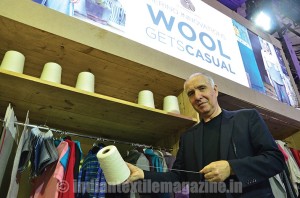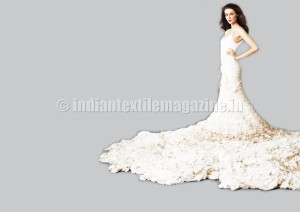Wool as clothing material has been used for centuries, and, despite the arrival of more complex artificial clothing fabrics, it continues to be used in the textile industry the world over. Generally, wool is used for making sweaters, blankets, quilts and other products for use in winter. Now many other products are made of wool which can be worn during summer as well.

At the 2015 edition of India Fashion Forum (IFF) held in Mumbai, we could interact with WOOLMARK, an iconic brand that has been representing quality wool for decades. The Woolmark brand is owned by the Australian Wool Innovation (AWI), a non-profit company owned by more than 27,000 wool growers. Its main mission is to enhance profitability, international competitiveness and sustainability of the Australian wool industry, while at the same time expanding demand for Australian wool.
Over decades of research, development and marketing, Woolmark Company aimed to establish wool as one of the most versatile, practical and best-loved natural fibres – a fibre that is unparalleled when manufactured into affordable, sophisticated products with high-performance qualities.
Wool fabric usually stand up to years of everyday wear and tear, making it the perfect choice for interior products, including upholstery, carpets, floor coverings, curtains as well as sleepwear, blankets, cushions and throws, the company reports.
The Wool Lab is the result of extensive research undertaken by Woolmark Company through its global network to select the best and most innovative wool fabrics and yarns worldwide and identify emerging trends. The company also uses the logo in its global marketing campaigns to promote the benefits of wool and ensure that consumers have a range of quality Merino apparel to buy, enjoy and treasure. In particular the logo accompanies the ‘Merino. No Finer Feeling’ fibre advocacy campaign that establishes Merino wool as the fabric of choice for fine, contemporary fashion.
Manufacturing process
Wool manufacture begins with shearing the sheep held once a year, usually in the springtime. The fleece recovered from a sheep can weigh between 2.5 to 8 kg. While most sheep are still sheared by hand, new technologies have been developed that use computers and sensitive, robot-controlled arms to do the clipping.
Then, in the sorting process, the wool is broken up into sections of different quality fibers, from different parts of the body. The best quality of wool comes from the shoulders and sides of the sheep and is used for clothing; the lesser quality comes from the lower legs and is used to make rugs.
After grading and sorting, the next process is cleaning. The raw wool, also known as grease wool taken directly from the sheep, follows a series of alkaline baths with water, soap and soda ash. This process removes sand, dirt, grease and dried sweat from the fleece. The weight of contaminants accounts for about 30-70 per cent of the initial estimation.
Next, the fleece is carded – passed through a series of metal teeth that straighten and blend the threads into slivers. Carding also removes residual dirt and other matter left in the fibers.
Spun into yarn
After being carded, the wool fibers are spun into yarn. Spinning for woollen yarns is typically done on a mule spinning machine, while worsted yarns can be spun on any number of spinning machines. This is followed by weaving and finishing. Although wool fibers can be dyed before carding, dyeing can also be done after the wool has been woven into fabric.
“There is a lot of R&D that goes into finishing and processing, which is the most important step from a consumer’s point. This process determines the final look and feel aspect of the finished product. Woollen garments processed in the right way would never cause irritation to the skin. There is a big misunderstanding that wool can be used only for outerwear. I can assure you, Merino Wool, when used as the base layer, is sensitive to your skin and gives you a long-lasting freshness. It is the perfect all-weather fibre,” says Mr. Roy Kettlewell of Woolmark.
Advantages of woollen garments
Wool is a breathable fibre that provides instant warmth, unlike synthetic materials. It regulates itself to individual body temperature and really is warm in winter whilst cool in summer. It is also a great buffer against rain, wind and snow.
The scientific reasons for these ‘miraculous’ properties are that in cold temperatures wool removes moisture from the skin, whilst at the same time its insulating qualities trap dry air and warmth. In warm temperatures, wool’s breathable qualities draw in air which removes excess heat and moisture from the body, helping the wearer stay cool.
Besides, wool is naturally water-resistant, repelling moisture vapour through its fibres and making it resistant to rot, mould and mildew. Again, wool’s unique structure means that it won’t allow the build-up of body odours, so you can keep wearing those same socks for days together.
Indian market
Out of the overall 330 million kilos of wool produced in Australia, less than 10 per cent reaches the Indian shores. Nearly 75 per cent is consumed by China every year. A number of textile players in Ludhiana are working with the Woolmark brand for many years. Raymonds has a separate collection of premium suiting using merino wool. A growing number of Indian designers are showing interest in woollen fibres for their premium ethnic wear collections.
